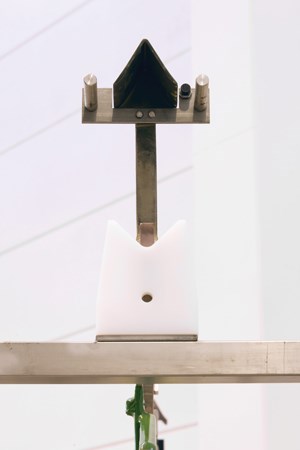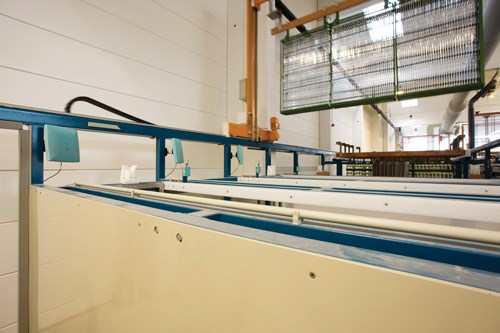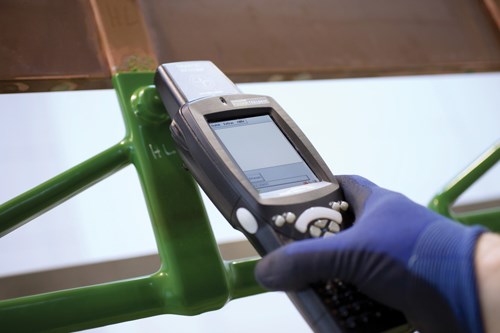Radio Frequency Identification systems can automate and optimize operational sequences during electroplating, especially with automotive parts. The operator of a new plant can often reduce error-prone manual inputs, making the production more efficient and transparent than ever before.
To expand production capacities and be able to offer the highest quality and delivery dependability into the future, the Kunststofftechnik Bernt GmbH in Kaufbeuren, Germany constructed a completely new electroplating facility from scratch. The plant in the Allgaeu region is a supplier for high-quality plastic parts and electroplating surface treatments such as copper and chrome plating primarily to the automotive, household appliance and sanitary industries.
The Metzka GmbH of Schwan-stetten, Germany designed and implemented the electroplating facility utilizing new process and automation technology, including RFID technology to be used for controlling, monitoring and tracking the flow of goods and flow of product carriers.
Higher Efficiency, Through Transparency
Kunststofftechnik Bernt wanted to better manage the inventory and the flow of raw and finished parts than was possible in the past.
When electroplating plastic parts—even with an optimized automated process control—a certain proportion of parts will suffer from blisters, pores, dull spots and similar flaws, which is why the electroplated parts have to be thoroughly inspected. The results need to be documented, good and bad parts recorded, and the inventory continuously updated on the warehouse computer. The faster and more accurately all of this is done, the more effective any intervention or countermeasure will be, should errors in the electroplating process occur—thus minimizing the scrap.
“Without increasing the degree of automation in the internal logistics, all of that would not be possible; which is why we were interested from the beginning in a comprehensive networking as well as modern, tried and tested methods for automatically tracking the product and the production via RFID—thereby further reducing the manual inputs,” says Dr. Ing Carsten Brockmann, managing director of Kunststofftechnik Bernt.
Production orders from the Bernt headquarters in Kaufbeuren can be entered into the ‘Enterprise Resource Planning’ system of the new electroplating plant and be executed there largely automated. In doing so, production planners know precisely and in real-time which parts and how many of them are located where and in what condition. A direct link between the final inspection and the CAQ system keeps the inventory up-to-date and makes sure that for shortfalls due to scrap, a follow-up order is automatically generated and entered.
Mixed Doubles for Performance
Product carrier bars made of copper—from which the product carrier racks loaded with different products are suspended—are stored on movable charging trolleys and brought into the electroplating process at currently three loading stations. There, a transport trolley/elevator picks them up and automatically takes them to the correct dipping bath.
For identifying the product carrier bars at the loading stations, an identification system was chosen. The ultra high frequency system, which has long been used in logistics, is now also increasingly used in the production. One reason for this are the longer reading distances of up to 5 m (which can also be precisely limited) so that rail-bound transport systems are not required, and there is greater freedom in the mounting of the antennas.
Another reason is the easy connection of the read/write devices to PLC or PC systems using Ethernet connections. The copper bars are equipped with RFID tags, which can be screwed directly into metal and have proven themselves in the automotive industry, such as during the engine assembly where they likewise only provide their tag ID.
In the first stage, three circularly polarized antennas are installed for each loading station. Up to two antennas can be operated with one read/write device; the planned expansion to six loading stations thus only requires one extra reader. The connection to the system controller takes place via an interface module mounted at the rear of the loading area. There are no additional read/write points in the actual electroplating process; the route through the various chemical baths and rinsing tanks is stored in the controller and is unambiguous thanks to the RFID tag read.
For this, the numerous product carrier racks that are customized for each product have to be marked in some form or another. In the past, this was accomplished with soldered on badges, which sooner or later literally dissolved or detached in the aggressive electroplating baths. Someone thus came up with the idea of integrating contactless readable mobile data storage units (RFID tags) underneath the obligatory PVC coating protecting the racks. The only obstacle was the PVC coating is applied at a temperature of approximately 160°C, which severely limits the selection of suitable RFID tags.
Designed to withstand temperatures up to 180°C and small enough to be incorporated into the product carrier racks, button-sized mobile data storage units fit the bill. For this, Kunststofftechnik Bernt constructed a small plastic capsule, which is encased in an “eye” of the rack and also keeps the necessary distance to metallic parts. Only the unique tag number is stored on the RFID tag, which unmistakably identifies each one of roughly 500 product carrier racks and their products.
An assignment and tracking as they pass through is achieved by linking the product carrier racks with one of the approximately 100 product carrier bars. If there is no product carrier bar set up and ready to go in stock for an order/product, the linking with up to nine racks is performed in the setup area of the plant via the mobile handheld RFID terminal integrated into the local wireless LAN. A touch panel installed in the setup area displays the bars and racks required for an order, and permits the adjustment of quantities.
When setting up new product carrier racks, the operator selects the number of the bar and briefly holds the handheld reader near (maximum distance of approximately 60 mm) the eye with the RFID tag at the respective rack. The reader detects the rack number, which the operator acknowledges, and the rack is linked with the product carrier bar. By means of the bar and rack numbers, the electroplating controller knows exactly which process steps with which parameters (currents, times, temperatures, etc.) the products have to run through.
System Mix simplifies Machine Construction
The cycle at Kunststofftechnik Bernt is closed by entering the current production data (good/bad parts, error types) into the CAQ system. At the moment, this is still done via Excel spreadsheets; in the future, separate terminals will be installed for this at the final inspection to provide feedback to the process and the planning even faster and more conveniently.
The RFID tags in the product carrier racks are also used to automatically acquire the number of process runs and thus to obtain a uniform, optimized “service life”. The service life is limited, since the PVC coating becomes porous over time and has to be renewed so that the quality of the electroplating is not adversely affected. The operator now automatically receives a message if a certain rack has reached the allotted number of runs, and can plan the maintenance accordingly. The operator can also demetalize racks, which is necessary after each plating process to maintain the dimensional accuracy of the parts receptors.
The running process is visualized by a visualization system, which was tailored to the needs of the operator by Metzka. On screens in the production and in the foreman’s office, it depicts an exact image of the current positions or states of all transport trolleys, product carrier bars and electroplating baths. Furthermore, the plant constructor has implemented a trend analysis for the temperatures and current/voltage characteristics of the rectifiers on the basis of the visualization system, which receives its data directly from the central system controller.
Efficient RFID Engineering
“The transition from the trial to the full live operation was seamless, and especially with respect to the automation technology, went absolutely trouble-free,” says Peter Keila from the technical management at Metzka.
“The personnel from all electroplating areas quickly took to heart the new processes, and the advantages expected in the daily operations materialized.” n
Birgit Gottsauner with Siemens AG’s Industry Automation sector can be reached at birgit.gottsauner@siemens.com.
















.jpg;maxWidth=300;quality=90)







